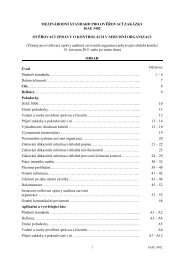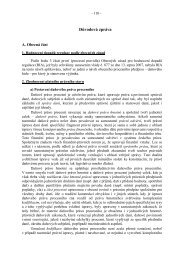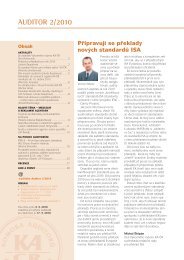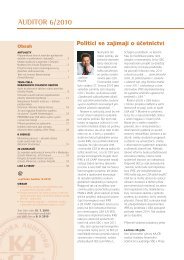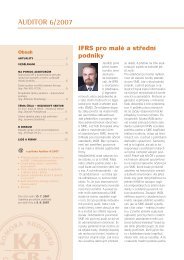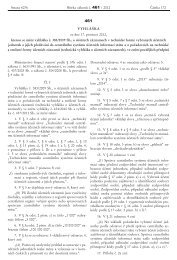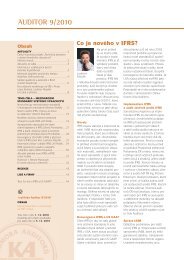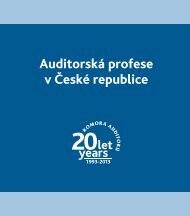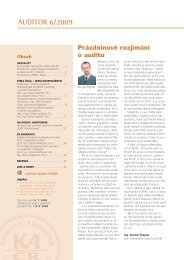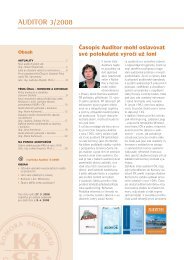Guide to Using International Standards on Auditing in - IFAC
Guide to Using International Standards on Auditing in - IFAC
Guide to Using International Standards on Auditing in - IFAC
You also want an ePaper? Increase the reach of your titles
YUMPU automatically turns print PDFs into web optimized ePapers that Google loves.
34<br />
<str<strong>on</strong>g>Guide</str<strong>on</strong>g> <str<strong>on</strong>g>to</str<strong>on</strong>g> <str<strong>on</strong>g>Us<strong>in</strong>g</str<strong>on</strong>g> <str<strong>on</strong>g>Internati<strong>on</strong>al</str<strong>on</strong>g> <str<strong>on</strong>g>Standards</str<strong>on</strong>g> <strong>on</strong> <strong>Audit<strong>in</strong>g</strong> <strong>in</strong> the Audits of Small- and Medium-Sized Entities Volume 1—Core C<strong>on</strong>cepts<br />
Benefits<br />
Audit Team’s<br />
Effort Focused<br />
<strong>on</strong> Key Areas<br />
Audit Procedures<br />
Focused <strong>on</strong><br />
Specific Risks<br />
Understand<strong>in</strong>g<br />
of Internal C<strong>on</strong>trol<br />
Timely<br />
Communicati<strong>on</strong><br />
of Matters of<br />
Interest <str<strong>on</strong>g>to</str<strong>on</strong>g><br />
Management<br />
Descripti<strong>on</strong><br />
By understand<strong>in</strong>g where the risks of material misstatement can occur <strong>in</strong> f<strong>in</strong>ancial<br />
statements, the audi<str<strong>on</strong>g>to</str<strong>on</strong>g>r can direct the audit team’s effort <str<strong>on</strong>g>to</str<strong>on</strong>g>ward high-risk areas and<br />
perhaps reduce work <strong>in</strong> lower-risk areas. This will also help <str<strong>on</strong>g>to</str<strong>on</strong>g> ensure that audit staff<br />
resources are used effectively.<br />
Further audit procedures are designed <str<strong>on</strong>g>to</str<strong>on</strong>g> resp<strong>on</strong>d <str<strong>on</strong>g>to</str<strong>on</strong>g> assessed risks. C<strong>on</strong>sequently,<br />
tests of details that <strong>on</strong>ly address risks <strong>in</strong> general terms may be significantly reduced<br />
or even elim<strong>in</strong>ated.<br />
The required understand<strong>in</strong>g of <strong>in</strong>ternal c<strong>on</strong>trol enables the audi<str<strong>on</strong>g>to</str<strong>on</strong>g>r <str<strong>on</strong>g>to</str<strong>on</strong>g> make <strong>in</strong>formed<br />
decisi<strong>on</strong>s <strong>on</strong> whether <str<strong>on</strong>g>to</str<strong>on</strong>g> test the operat<strong>in</strong>g effectiveness of <strong>in</strong>ternal c<strong>on</strong>trol. Tests<br />
of c<strong>on</strong>trols (for which some c<strong>on</strong>trols may <strong>on</strong>ly require test<strong>in</strong>g every three years) will<br />
often result <strong>in</strong> much less work be<strong>in</strong>g required than perform<strong>in</strong>g extensive tests of<br />
details. (See Volume 2, Chapter 17.)<br />
The improved understand<strong>in</strong>g of <strong>in</strong>ternal c<strong>on</strong>trol may enable the audi<str<strong>on</strong>g>to</str<strong>on</strong>g>r <str<strong>on</strong>g>to</str<strong>on</strong>g> identify<br />
weaknesses <strong>in</strong> <strong>in</strong>ternal c<strong>on</strong>trol (such as <strong>in</strong> the c<strong>on</strong>trol envir<strong>on</strong>ment and general IT<br />
c<strong>on</strong>trols) that were not previously recognized. Communicat<strong>in</strong>g these weaknesses <str<strong>on</strong>g>to</str<strong>on</strong>g><br />
management <strong>on</strong> a timely basis will enable them <str<strong>on</strong>g>to</str<strong>on</strong>g> take appropriate acti<strong>on</strong>, which is<br />
<str<strong>on</strong>g>to</str<strong>on</strong>g> their benefit. This may also save time <strong>in</strong> perform<strong>in</strong>g the audit.<br />
3.6 ISAs for Smaller Audits<br />
Paragraph #<br />
Relevant Extracts from Applicati<strong>on</strong> Material <strong>in</strong> ISAs<br />
200.A63 When appropriate, additi<strong>on</strong>al c<strong>on</strong>siderati<strong>on</strong>s specific <str<strong>on</strong>g>to</str<strong>on</strong>g> audits of smaller entities and public<br />
sec<str<strong>on</strong>g>to</str<strong>on</strong>g>r entities are <strong>in</strong>cluded with<strong>in</strong> the applicati<strong>on</strong> and other explana<str<strong>on</strong>g>to</str<strong>on</strong>g>ry material of an ISA.<br />
These additi<strong>on</strong>al c<strong>on</strong>siderati<strong>on</strong>s assist <strong>in</strong> the applicati<strong>on</strong> of the requirements of the ISA <strong>in</strong> the<br />
audit of such entities. They do not, however, limit or reduce the resp<strong>on</strong>sibility of the audi<str<strong>on</strong>g>to</str<strong>on</strong>g>r <str<strong>on</strong>g>to</str<strong>on</strong>g><br />
apply and comply with the requirements of the ISAs.<br />
200.A64 For purposes of specify<strong>in</strong>g additi<strong>on</strong>al c<strong>on</strong>siderati<strong>on</strong>s <str<strong>on</strong>g>to</str<strong>on</strong>g> audits of smaller entities, a “smaller<br />
entity” refers <str<strong>on</strong>g>to</str<strong>on</strong>g> an entity which typically possesses qualitative characteristics such as:<br />
(a) C<strong>on</strong>centrati<strong>on</strong> of ownership and management <strong>in</strong> a small number of <strong>in</strong>dividuals (often<br />
a s<strong>in</strong>gle <strong>in</strong>dividual—either a natural pers<strong>on</strong> or another enterprise that owns the entity<br />
provided the owner exhibits the relevant qualitative characteristics); and<br />
(b) One or more of the follow<strong>in</strong>g:<br />
(i) Straightforward or uncomplicated transacti<strong>on</strong>s;<br />
(ii) Simple record-keep<strong>in</strong>g;<br />
(iii) Few l<strong>in</strong>es of bus<strong>in</strong>ess and few products with<strong>in</strong> bus<strong>in</strong>ess l<strong>in</strong>es;<br />
(iv) Few <strong>in</strong>ternal c<strong>on</strong>trols;<br />
(v) Few levels of management with resp<strong>on</strong>sibility for a broad range of c<strong>on</strong>trols; or<br />
(vi) Few pers<strong>on</strong>nel, many hav<strong>in</strong>g a wide range of duties.<br />
These qualitative characteristics are not exhaustive, they are not exclusive <str<strong>on</strong>g>to</str<strong>on</strong>g> smaller entities,<br />
and smaller entities do not necessarily display all of these characteristics.<br />
200.A65 The c<strong>on</strong>siderati<strong>on</strong>s specific <str<strong>on</strong>g>to</str<strong>on</strong>g> smaller entities <strong>in</strong>cluded <strong>in</strong> the ISAs have been developed<br />
primarily with unlisted entities <strong>in</strong> m<strong>in</strong>d. Some of the c<strong>on</strong>siderati<strong>on</strong>s, however, may be helpful<br />
<strong>in</strong> audits of smaller listed entities.<br />
200.A66 The ISAs refer <str<strong>on</strong>g>to</str<strong>on</strong>g> the proprie<str<strong>on</strong>g>to</str<strong>on</strong>g>r of a smaller entity who is <strong>in</strong>volved <strong>in</strong> runn<strong>in</strong>g the entity <strong>on</strong> a<br />
day-<str<strong>on</strong>g>to</str<strong>on</strong>g>-day basis as the “owner-manager.”




